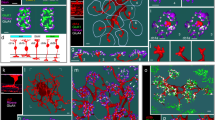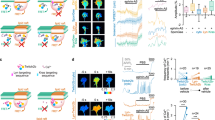Abstract
THE dynamic nature of neuronal growth cone filopodia led to the suggestion that the primary function of filopodia is to sample their immediate environment1–3, responding to and transducing environmental signals that affect growth cone behaviour4–6 and shape7–11. Filopodia seem well suited to serve as antenna-like sensors, their broad span allows sampling of information over a greatly enhanced radius, and forward-projecting filopodia encounter potential cues in the molecular terrain long before the advancing growth cone itself12. Filopodia in culture can serve structural roles13, exert mechanical tension14–16 and selectively adhere to their surrounding17–20. Whether or not filopodia have a general sensory role has not been tested directly, largely because of their small size, which limits an electrophysiological approach, and their integral relationship with the parent growth cone, which prevents resolution of their different functions. Here we use surgical procedures to isolate individual filopodia from their parent growth cone and, by monitoring their morphology and calcium second messenger systems, we show that neuronal growth cone filopodia contain signal transduction mechanisms that allow autonomous responses and the transmission of distant environmental information to their parent growth cone.
This is a preview of subscription content, access via your institution
Access options
Subscribe to this journal
Receive 51 print issues and online access
$199.00 per year
only $3.90 per issue
Buy this article
- Purchase on Springer Link
- Instant access to full article PDF
Prices may be subject to local taxes which are calculated during checkout
Similar content being viewed by others
References
Sperry, R. W. Proc. natn. Acad. Sci. U.S.A. 50, 703–710 (1963).
Bonhoeffer, F. & Gierer, A. Trends Neurosci. 7, 378–381 (1984).
Tessier-Lavigne, M. & Placzek, M. Trends Neurosci. 14, 303–310 (1991).
Letourneau, P. C., Kater, S. B. & Macagno, E. R. The Nerve Growth Cone 1–535 (Raven, New York, 1991).
Bandtlow, C. T. Z. & Schwab, M. E. J. Neurosci. 10, 3837–3848 (1990).
O'Connor, T. P., Duerr, J. S. & Bentley, D. J. Neurosci. 10, 3935–3946 (1990).
Bovolenta, P. & Mason, C. J. Neurosci. 7, 1447–1460 (1987).
Taghert, P. H., Bastiani, M. J., Ho, R. K. & Goodman, C. S. Devl Biol. 94, 391–399 (1982).
Tosney, K. W. & Landmesser, L. T. J. Neurosci. 5, 2345–2348 (1985).
Eisen, J. S., Myers, P. Z. & Westerfield, M. Nature 320, 269–271 (1986).
Holt, C. E. J. Neurosci. 9, 3123–3145 (1989).
Rehder, V. & Kater, S. B. J. Neurosci. 12, 3175–3186 (1992).
Goldberg, D. J. & Burmeister, D. W. J. Cell Biol. 103, 1921–1931 (1986).
Nakai, J. & Kawasaki, Y. Z. Zellforschung 51, 108–122 (1959).
Heidemann, S. R., Lamoureux, P. & Buxbaum, R. E. J. Cell. Biol. 111, 1949–1957 (1990).
Bray, D. Nature 244, 93–96 (1973).
Bray, D. J. Cell Sci. 37, 391–410 (1979).
Hammarback, J. A. & Letourneau, P. C. Devl. Biol. 117, 655–662 (1986).
Gundersen, R. W. J. Neurosci. Res. 21, 298–306 (1988).
Letourneau, P. C. & Shattuck, T. A. Development 105, 505–519 (1989)
Silver, R. A., Lamb, A. G. & Bolsover, S. R. Nature 343, 751–754 (1990).
Cohan, C. S., Connor, J. A. & Kater, S. B. J. Neurosci. 7, 3588–3599 (1987).
Lipscombe, D. et al. Proc. natn. Acad. Sci. U.S.A. 85, 2398–2402 (1988).
Bedlack, R. S. Jr., Wei, M.-D. & Loew, L. M. Neuron 9, 393–403 (1992).
Davenport, R. W. & Kater, S. B. Neuron 9, 405–416 (1992).
Haydon, P. G. & Man-Son-Hing, H. Neuron 1, 919–927 (1988).
Haydon, P. G., McCobb, D. P. & Kater, S. B. Science 226, 561–564 (1984).
Mattson, M. P., Dou, P. & Kater, S. B. J. Neurosci. 8, 2087–2100 (1988).
McCobb, D. P., Cohan, C. S., Connor, J. A. & Kater, S. B. Neuron 1, 377–385 (1988).
Mattson, M. P. & Kater, S. B. Brain Res. 478, 337–348 (1989).
Mills, L. R. & Kater, S. B. Neuron 4, 149–163 (1990).
Wong, R. G., Hadley, R. D., Kater, S. B. & Hauser, G. C. J. Neurosci. 1, 1008–1021 (1981).
Grynkiewicz, G. T., Poenie, M. & Tsien, R. J. biol. Chem. 260, 3440–3450 (1985).
Uto, A., Arai, H. & Ogawa, Y. Cell Calcium 12, 29–37 (1991).
Author information
Authors and Affiliations
Rights and permissions
About this article
Cite this article
Davenport, R., Dou, P., Rehder, V. et al. A sensory role for neuronal growth cone filopodia. Nature 361, 721–724 (1993). https://doi.org/10.1038/361721a0
Received:
Accepted:
Issue Date:
DOI: https://doi.org/10.1038/361721a0
This article is cited by
-
Modeling membrane nanotube morphology: the role of heterogeneity in composition and material properties
Scientific Reports (2020)
-
Targeted inhibition of fascin function blocks tumour invasion and metastatic colonization
Nature Communications (2015)
-
Tanshinone IIA Rescued the Impairments of Primary Hippocampal Neurons Induced by BV2 Microglial Over-Activation
Neurochemical Research (2015)
-
A critical role for STIM1 in filopodial calcium entry and axon guidance
Molecular Brain (2013)
-
The role of filopodia in the recognition of nanotopographies
Scientific Reports (2013)
Comments
By submitting a comment you agree to abide by our Terms and Community Guidelines. If you find something abusive or that does not comply with our terms or guidelines please flag it as inappropriate.



